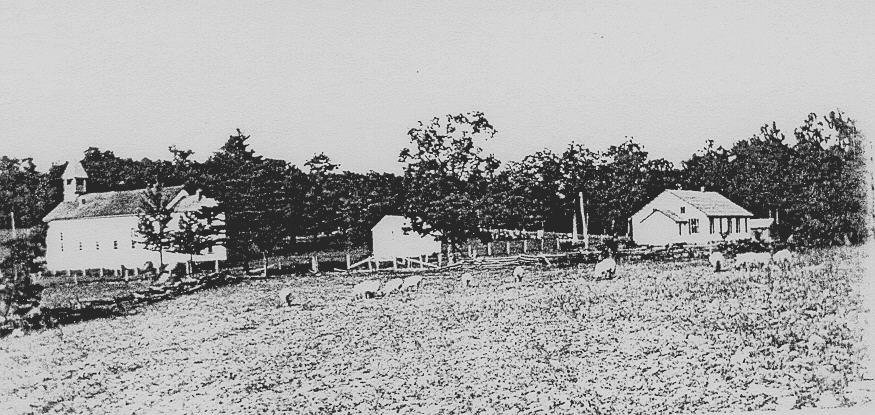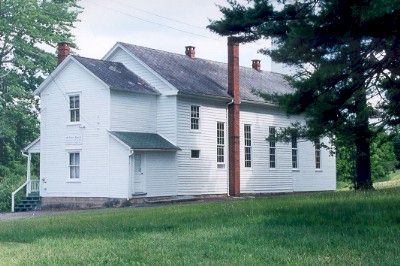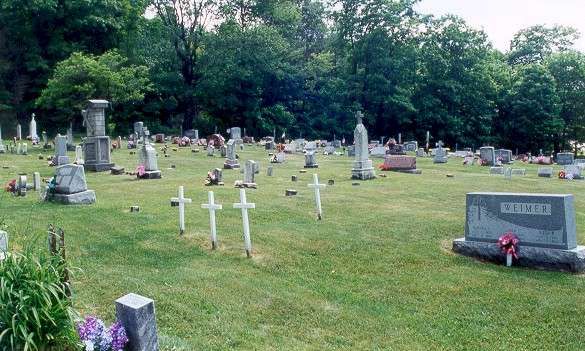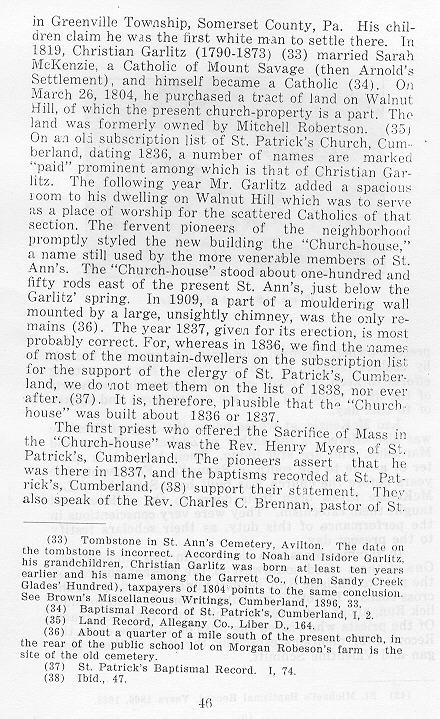Avilton, Maryland



History of St. Ann Parish and the Christian Garlitz Family



History of St. Ann Parish and the Christian Garlitz Family
"The wife of Christian Garlitz III, Sarah McKenzie, Catholic; her husband became a loyal son of that church, as are his descendants of Avilton today."
Editor's note: Many early Garlitzs from the area are found in the records of the German Reformed and Lutheran Churches. A Henry Garlitz, probably the father of Christian III, is found in the records of St. Johns Reformed in Salisbury, PA. Several of Christian III sisters are recorded as being christened there. Some records have Christian I buried at St. Ann Cemetary in Avilton, MD., but this could not be correct. The marker to Pioneer Christian Garlitz refers to Christian III. All three Christians were considered pioneers in the stories.
About 1836 parish priest of St. Patrick's Church, Cumberland began a "mission" in the "McKenzie Settlement." It was probably the next year that Christian Garlitz added a spacious room to his log house at Walnut Hill known as the "Church-house, which was to serve as a place of worship for the scattered Catholics of that section.
After Henry Garlitz (son of Christian III) sold the farm and "Church-house", mass was celebrated in the homes of Samuel and Lee McKenzie, and, in summer, in two school houses nearby.
In 1871 there were about fifteen Catholic families in the McKenzie settlement; it was then decided to build a church. Rev. Father Schmidt selected the site on the road at Walnut Hill, one hundred fifty rods northwest of the former "Church-house," or Garlitz homestead, where an acre of land for the purpose was donated by Jeremiah McKenzie and his wife Catherine.
On September 24, 1871, the new church cornerstone was laid. Christian Garlitz striking "the first lick. The carpenters were James McKenzie and Ozia Weimer. The building of St. Ann's is said to have cost $2000 in addition to some labor and materials which were donated. It is a handsome, well built structure, nestling in a little pine grove at an altitude of 2770 feet. A well-kept cemetery is behind the church.
St. Ann's Church was dedicated Aug. 29, 1874, the occasion for a procession from Frostburg and mass in the new edifice, witnessed by a large assemblage from the surrounding country. In 1815 [sic] an addition to the site was purchased and a commodious hall erected, which serves as a community center for meetings and entertainments.
Good old Christian Garlitz was killed by the fall of a tree before the dedication of the new church, in which he took so much interest. Tho an old man, he insisted upon helping cut some timber near his home; he was struck on the head and died the same afternoon.
He is buried in St. Ann's Cemetery. A respectable marble shaft marks the resting place of his mortal remains:
Originally written by Charles E. Hoye (published on February 7, 1935)
[The preceding article was published in the Mountain Democrat on the above date and a copy found at the Maryland Historical Society in Filing Case A.]
From History of St. Stephen and St. Ann Parishes


It is interesting to note that the writer of this history makes the error of merging the three Christian Garlitzs into one. A common mistake. Christian III, the Christian Garlitz of St. Ann Parish, was the son of Henry Garlitz, and the great grandson of the John Garlitz refered to in the above article.
In the above photo, the house below St. Ann's is the Garlitz Homestead. The X marks the spot of the "Church House", that is, the location of the log house of Christian Garlitz III to which he had built the addition for use as a church.

The home of Samuel McKenzie also served as a church for some years. This house stood about a half mile south of the present St. Ann's. "Samuel McKenzie distinguished himself by zealous interset in church affirs. His unremitting efforts to keep the flame of faith burning in the hearts of the little mountain flock are remembered and spoken of to this day. ... For twenty-five years before the church was buildt both Samuel and Leo McKenzie threw open their doors to the children and taught them catechism. They were very consientious in the performance of this duty, as their scholars testify to the present day." From the History of St. Ann's Mission. 1920.